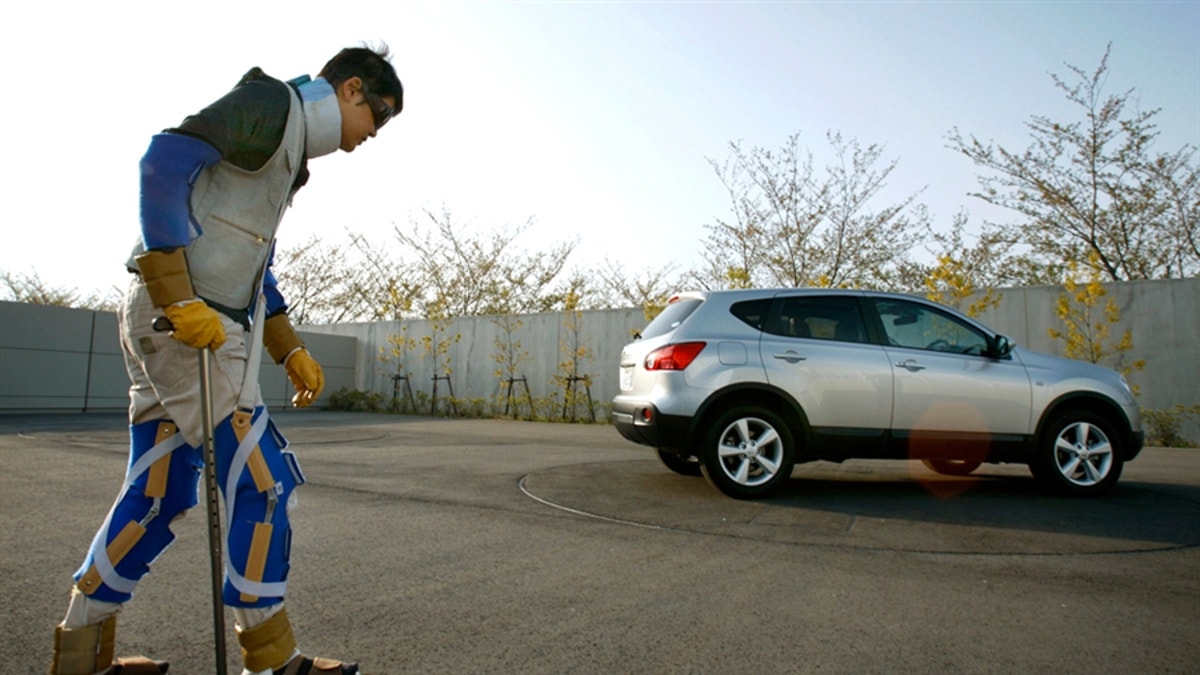
Nissan "ageing suit" demonstration. (Reuters)
Bulky suits that mimic the range of motion of an octogenarian, goggles that simulate cataracts and rear seat airbags designed to protect frail spines are all part of the automotive industry's arsenal in its quest to build safer cars for the world's aging population.
In a country built on the idea of personal transportation, simply taking keys from older drivers may not be an option, so automakers are tapping technology to make their cars safer to drive, even by those whose abilities aren’t what they used to be.
“This is one of the big trends out there,” says Pete Hardigan, Ford’s manager of advanced safety rule making.
It starts with developers trying to better understand the challenges facing maturing drivers. Beyond simply speaking with them or observing them behind the wheel, automakers like Ford and Nissan have developed special “old age” suits, worn by engineers, that use a system of straps and braces to restrict their movement in the same way that a debilitating condition like arthritis can. Sight-limiting goggles do the same to simulate reduced vision.
Features like blind spot monitoring and lane departure prevention systems that use cameras and radars to monitor the area around the car are already on the road and can offer visual and auditory warnings and intervene if a vehicle starts to drift out of its lane, or its driver turns toward a car alongside it. With one of these “third age” suits, as Ford calls them, an engineer can get a feel for how these aids can be optimized for a driver who has slower reflexes and limited mobility.
Active cruise control can also double as a collision detection system, pre-charging the brakes and setting off attention-getting alarms to call the driver to action when an accident is imminent. Hardigan says Ford has developed a computer algorithm that uses the data being generated by these types of systems to determine if a driver is dozing off, initiating a series of chimes to keep them alert.
Volvo has taken active safety to new levels with a crash intervention system already available on some of its cars called City Safety that can autonomously slam on the brakes if it detects a stopped car or a pedestrian in the road ahead. Meanwhile, Mercedes-Benz and BMW both offer night-vision cameras that display enhanced images on a dashboard-mounted display that highlight potential obstacles.
To help avoid close calls in the first place, many automakers, including Ford, are working on telematics networks that will let vehicles on the road to “talk” to each other by communicating their speed and location so that they can predict potential accidents and take evasive measures long before the proximity sensors even kick in.
Ford also has begun to address the special needs of elderly passengers in the event of an unpreventable accident. Hardigan says it has found that older people are particularly susceptible to thoracic injuries, which is part of the reason the company developed seatbelt-mounted rear airbags. Unlike standard belts, these spread the force of impact over a larger area of the body, cushioning the blow, and also help reduce whiplash by keeping a passenger's head from swinging too far forward.
No one is out to design a car that’s just for seniors, however, and all of this technology is being developed with drivers and passengers of all ages in mind. A study by the Insurance Institute for Highway Safety found that up to one-third of fatal crashes could be avoided by the use of these types of systems.
Of course, the Holy Grail of safety for drivers who have seen better days is the fully autonomous car, like the ones currently being tested by Google on public roads in California. The former head of Research and Development at General Motors, Larry Burns, recently predicted that they could start appearing in showrooms as early as 2020, just about the time the “silver tsunami” will begin to hit the road with full force.